I’m going to skip the long, drawn out intro on this one – no one really reads it anyway – and instead just sum up the purpose of this article with three simple words: I love animals. Okay, maybe I need a few more words. I suppose I just find animals endlessly fascinating. Although we know so much about so many of them, a lot still remains a mystery. I chose to include facts I personally found interesting and grouped them by animals so you can opt to read all of the facts or just check out a few neat facts on your favorite animal. All images are via Wikipedia (unless noted otherwise). Enjoy!
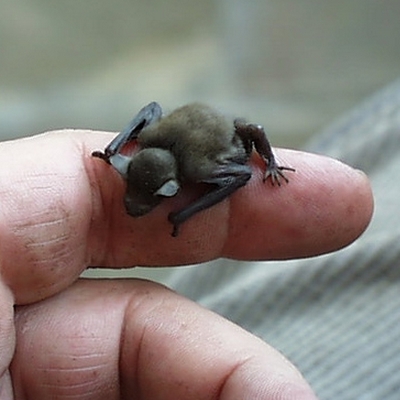
Crazy Facts About Bats
- Bats are not, in fact, blind. Although they use radar to locate objects and navigate, they can actually see.
- Bats hibernate; slowing their breathing, heart rate and other functions so they are able to conserve energy.
- Vampire bats are real. They originate in South America and do, in fact, consume blood. This is how the vampire/bat connection first became part of vampire folklore.
- There are more than 1,000 known species of bat. These species are separated into two subspecies; Megachiroptera and Microchiroptera or large bats and small bats.
- Bats are the only mammals capable of controlled, self-propelled flight. This one is probably pretty common knowledge by now but I still find it fascinating and hey, I love bats so any time I have the chance to write about them, I take it!
- Bats hang upside down because their limbs are not strong enough to hold them upright. For this reason, they must sleep hanging upside down. This also means their legs are not strong enough to allow them to walk. Why do they even have legs in the first place? It sort of seems like a cruel evolutionary prank, doesn’t it? You can have legs but we’re not going to let you use them for anything. Not nice, nature.
- The bumblebee bat, named for the fact that it is roughly the same size as a bumblebee, is the world’s smallest known mammal. It measures only 29-33 mm long, weighs only 2 grams and has a wingspan that is only 170 mm.
- Bumblebee bats are able to hover in the air thanks to the elongated tips of their wings.
- Bumblebee bats live in colonies that range in size from 10 bats to 100 bats.
- All sorts of weird (and terrible) things take place during war time. I think this qualifies as both weird and terrible. During World War II, Americans tried to train bats to drop bombs. By all accounts, these efforts were unsuccessful.

Crazy Facts About Caribou/Reindeer
- Both male and female caribou grow antlers but they lose their antlers at different times. Adult male caribou lose their antlers in December while younger males hold on to them until early spring. Female caribou have their antlers until summer.
- Caribou can be domesticated.
- Caribou and reindeer are the same thing.
- Male caribou are significantly larger than their female counterparts, weighing up to 700 lbs and standing up to 214 cm. Females, on the other hand, stand nearly as tall at 205 cm but weigh only 260 lbs.
- Caribou have dual coats. Their undercoat is a comprised of woolly fur while their overcoat is made up of hollow, air filled hairs.
- According to current research, caribou are the only animals able to see ultraviolet light.
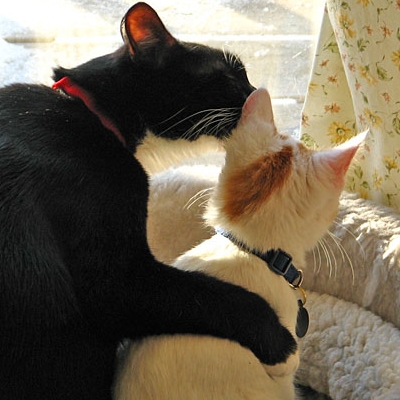
Crazy Facts About Cats
- Cats spend roughly 2/3 of their days sleeping. In other words, if you have a 9 year old cat, it has only actually been awake for about three years of its life. While they are awake, however, they spend roughly 1/3 of their day cleaning themselves.
- Cats do not have a sweet tooth. Although the exact reason for this isn’t known, research suggests the culprit may be a mutation in a key taste receptor.
- Cats do not bob their heads up and down while hunting prey the way a dog does. Instead, they keep their head down throughout the chase.
- Hairballs are gross. I think we all know that. Here’s something you may not know. There is actually a technical name for a cat’s hairball. That name? Bezoar. I need to call someone an annoying bezoar at some point in time. I’ve made a mental note.
- I had never considered whether or not cats could be right or left pawed but it turns out they can be. It also turns out the majority of female cats are right pawed and the majority of male cats are right pawed.
- Ever wondered why cats get stuck up trees? There is an answer! A cat’s claws are curved in a way that allows them to climb up trees rather easily. The trouble comes when they try to get down as the curve that helped them get up the tree makes it difficult, if not impossible, to climb back down. They must back down instead of trying to get down head first.
- The average cat is able to make up to 100 distinct vocal sounds. That doesn’t sound all that impressive until you consider dogs can only make somewhere around 10.
- The brain of a cat has a region that is responsible for emotion. The same region of the brain is responsible for emotion in human. In fact, a cat’s brain is more closely related to the brain of a human that it is to a dog’s brain.
- It is believed there are as many as 500 million domestic cats in the world today. In fact, more than 30% of the homes in North America have a cat as a pet, making them the most popular pet in North America by a long shot. How much of a long shot? There are 73 million domestic cats kept as pets in North America while there are only 63 million dogs.
- A 9,500 year old grave in Cypress recently revealed what has been called the oldest known domestic cat which predates ancient Egyptian artwork depicting cats by more than 4000 years. This means the Ancient Egyptians may not have been the first to domesticate the cat as it has long been believed.
- Pope Innocent VIII ordered the execution of thousands of cats during the Spanish Inquisition because he believed cats were evil. His gesture was repaid by a boom in the rat population which helped spread the Black Plague.
- Cats are capable of running up to 31 mph for short distances.
- A cat is capable of jumping up to 5 times its own height.
- The tail, face and paws of a cat contain scent glands so when your cat is rubbing against your legs, it isn’t just being affectionate. It is also marking you as its territory.
- Researchers have yet to discover why cats purr although they think they’ve discovered how it happens. It is believed a cat purrs by vibrating a vocal fold deep in its throat.
- In ancient Egypt, the passing of a cat was mourned by the entire family. The family in mourning would shave their eyebrows and hold elaborate funerals for the dearly departed. They would then have the cat embalmed and mummified, burying it in a pet cemetery along with mummified mice. More than 300, 000 mummified cats were discovered dressed in this way in 1888.
- The largest ever recorded litter of kittens contained 19; 15 of which survived.
- Siamese cats cross their eyes to try to correct double vision common with the breed. The double vision is the result of the way the Siamese cat’s brain is wired. Most of the nerves from the left side of the brain connect to the right eye and most of the nerves from the right side of the brain connect to the left eye, causing the double vision that causes them to cross their eyes.
- Cats would make awesome detectives. When it was noticed that two Siamese cats in the Holland embassy in Moscow, Russia, kept scratching and meowing in the same part of a wall, the owners decided it was worth investigating. They expected to find mice or rats. Instead, they found bugs. More specifically, they found planted bugs; microphones hidden by Russian spies. Turns out, the cats could hear the microphones when they were turned on. No word on whether or not the kitties were given positions within the Embassy.
- Isaac Newton, a well known lover of cats, invented the cat flap to protect his experiments from his curious kitty, Spithead.
- Cats are unable to chew large pieces of food because they are not able to move their jaws sideways.
- The meow is a greeting reserved almost solely for humans. Cats rarely meow to other cats; choosing instead to purr, spit, hiss or growl at each other.
- The cat has 53 loose fitting vertebrae in its back allowing it great flexibility in its back. Humans are far more limited, having only 34.
- The key hormone for growth in kittens is only released when the kitten is sleeping.
- A healthy cat has an expected lifespan of roughly 20 years. There are exceptions though. Take Crème Puff – the world’s oldest recorded cat. Crème Puff died three days after her 38th birthday. She was born in 1967 and died in 2005. In human years, Crème Puff would’ve been about 96.
- The cat has more bones in its body than a human being (cats have 230 while humans have 206) but we do have one bone cats do not have – the collar bone. Cats do not have collar bones which allows them to fit into any space that is large enough for their head.
- Screw the idea that cats are for women. A 2007 Gallop poll showed that men were every bit as likely to own a cat as women.
- A cat’s heart beats between 110 and 140 times a minutes – almost twice as far as the human’s heart beats.
- Cats only sweat through their paws.
- Cats are incredibly sensitive to vibrations in the ground. It is believed cats can detect tremors from an earthquake at least 10 minutes before humans can.
- Cats have not undergone any major changes while being domesticated. Your domestic cat is probably not a whole lot different than its ancient, wild relatives.
- A female cat is called a queen.
- The claws on a cat’s rear feet do not retract and become worn over time. The claws on a cat’s front feet, do retract and do not take as much wear. For that reason, the cat’s front claws are often much sharper than their back claws.
- A poor, poor kitty named Andy had quite an adventure one day, falling from his owner’s apartment on the 16th story of an apartment building. He fell 200 feet – and survived.
- A much luckier cat, Hamlet, escaped from the carrier he was being transported in and hid behind a pane. He remained hidden for 7 weeks. By the time he was discovered and returned to his owner, Hamlet had traveled more than 373, 000 miles.
- A cat’s urine glows under a black light.
- The ridges on a cats nose has a pattern unlike any other cat’s, basically making them a cat’s fingerprints.
- A quivering tail means a very happy cat. This is the greatest expression of affection a cat can give to their human.
- Domestic cats are the only cats that walk with their tails straight up. Wild cats walk with their tails tucked between their legs or straight out behind them.
- If you talk to your cat often, it will be more likely to ‘talk’ to you.
- Very few cats have eyelashes.
- A cat’s eyes reflect light which is why they see so well in the dark. Their eyes basically work like tiny little flashlights.
- Cats rarely greet each other nose to nose but it isn’t completely unheard of. Cats who are comfortable with each other may greet each other in this manner, even if they have been separated for an extended period of time.
- Kittens have a monotone purr while older cats will purr in two or three resonant notes.
- Cats do not understand punishment. Instead, they need to be rewarded for good behavior instead of punished for bad behavior.
- Ever take note of how expressive a cat’s ears can be? You can credit that to the fact that cats have 32 muscles in each ear. That makes 64 ear muscles alone.
- Although hard to establish for certain, it is believed that cats have lived with humans for roughly 7,000 years.

Crazy Facts About Cheetahs
- Have you ever noticed that cheetah’s kind of look like they’re mascara is running thanks to those black streaks running down their cheeks? Turns out, they’re a reason for those. Those black tear streaks on a cheetah’s face prevent the sun from blinding the animal while it is stalking prey.
- So we all know cheetahs are fast, but did you know how fast? When a cheetah runs, it can reach up to 62 mph in only 5 seconds and may take as many as 150 breaths per minute. While it’s running at these speeds, the cheetah uses its tail like a rudder to steer itself.
- This really makes one think. A full grown cheetah can weigh approximately 160 lbs and can measure approximately 92 inches long (including the tail). Picture the size of that for a moment. Got it? Okay. The cheetah is the smallest of the big cats.
- Unlike most big cats, cheetahs cannot roar. Like many cats, however, cheetahs do purr. Side note, I once had the opportunity to hear a cheetah purr in person. It was so loud.
- Out of all the big cats, cheetahs are the least able to adapt to new environments.
- The cheetah has several different purrs. When a cheetah is searching out other cheetahs, it has a purr that sounds similar to a chirp. The cheetah has a stuttered sounding purr when it greets another cheetah. When a cheetah feels threatened, it will growl. If the danger becomes more imminent or they feel the level of danger has increased, the growl will become higher pitched, sounding more like a yowl. Finally, they have a standard purr when they feel content, especially when a mother cheetah is with her cubs.
- Cheetahs can change direction while jumping by spinning in mid air. They are one of the few large cats that can do this.
- Unlike many other predatory animals, the mother cheetah may take her cubs with her while she hunts but she attempts to ensure their safety by hiding them, most often under brush.
- Like me, cheetahs aren’t a big fan of the heat. Cheetahs do their hunting at night or early in the morning to avoid the heat of the mid to late afternoon.
- Cheetahs do not kill their prey with their teeth or claws, generally speaking. Instead, they choose to take out their prey by tripping it and then suffocating it.
- Male cheetahs are social animals but they’re also very territorial and will mark their territory by urinating on plants and trees.
- While in captivity, cheetahs have been known to live up to 20 years, their life span is only roughly 12 years in the wild.
- Male cheetahs mature faster than female cheetahs with males maturing around 12 months while females don’t generally mature until 24 months.
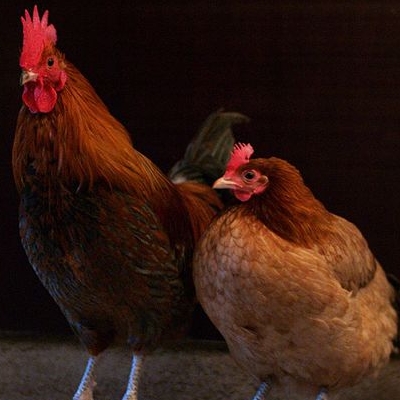
Crazy Facts About Chickens
- Chickens are the closest living relative of the tyrannosaurus rex.
- Chickens are actually able to fly, albeit rather unimpressively. The longest recorded flight by a chicken was 13 seconds.
- Chickens make certain sounds when a predator is near. This sound changes depending on the kind of predator.
- Here is something I did not know, despite the fact that I grew up with a chicken coop in the backyard of my family’s home. The color of a chicken’s eggs depends on the color of its earlobes. White earlobes mean white eggs. Red earlobes mean brown eggs. Now I know and so do you.

Crazy Facts About Dogs
- Dogs have three eyelids. The third lid is there to keep the eye lubricated and protected.
- All dogs have pink tongues. All dogs, that is, aside from the chow which has a purple or blue/black colored tongue – also known as the only breed of dog that has ever bitten me hard enough to draw blood and therefore, the only breed of dog that absolutely terrifies me.
- The shape of a dog’s face can indicate the expected lifespan of the dog. Dogs with longer, pointed faces such as German Shepherds and Dobermans are expected to live longer than dogs with shorter faces like bulldogs or pugs.
- Dachshunds (wiener dogs) were originally bred to fight badgers in their dens.
- Dalmatians are born completely white and don’t develop their distinctive black spots until later.
- When born, a puppy doesn’t have teeth and is both blind and deaf.
- American soldier, Lee Duncan, adopted a tiny puppy found wounded in battle in WWI and brought it home with him when he returned to the United States. That puppy was Rin Tin Tin – arguably the biggest canine superstar of all time.
- Before developing sight, hearing, smell or taste, the dog develops touch. Their entire bodies, including their paws, are covered in sensitive nerve endings.
- The first, clearly identifiable dog breed showed up around 9,000 BC. It is believed to have been an ancestor of the greyhound and was likely used for hunting.
- The oldest dog bones discovered thus far were found in Asia and have been dated back to 10,000 BC.
- There are roughly 400 million dogs in the world with the United States claiming the highest population of dogs followed by France.
- Like cats, dog nose prints are as distinctive as human fingerprints.
- A pack can consist of as few as two dogs and a dog is more likely to chase and hunt if it is part of a pack than it would be if it were a solitary dog.
- The average dog can reach a speed of up to 19 mph when running. Greyhounds are not average dogs though. The greyhound can reach a speed of up to 45 mph.
- The expected lifespan of a dog depends on the breed but we can say for certain the oldest known dog was an Australian cattle dog named Bluey who lived five months into his 29th year. If Bluey were a human, he would’ve been 160 years old when he died.
- If a person is standing 300 yards away from a dog and is standing perfectly still, the person will be almost entirely invisible to the dog. If the person were to wave their arms though, the person would be visible.
- Humans have 5 millions cells used for detecting smells. Dogs, on the other hand, have more than 220 million. The region of a dog’s brain that interprets smell is four times larger than the portion of a human’s brain that interprets smell. The wetness of a dog’s nose also helps their sense of smell as that wetness collects drops of smelling chemicals in the air.
- A dog’s sense of smell is so sharp, they can smell dead bodies under water, termites and where termites are hiding, and natural gas even if it is buried under up to 40 feet of dirt. Recent studies have also suggested dogs are capable of detecting cancer by simply smelling a person’s breath.
- Dogs have cats beat in the ability to taste department. While a cat has somewhere in the area of 470 taste buds, dogs have around 1,700. Humans still take the win in this department though. We have about 9,000 taste buds.
- A dog will lift its leg when urinating to hit higher marks on trees or posts to make it appear larger to other animals thinking about encroaching on its territory.
- Dogs can learn to understand up to 200 words as well as gestures or hand signals that represent words.
- Having trouble training your dog? Try gesturing as you give commands. Dogs learn commands more quickly if a gesture accompanies it. I want to use a joke about training your dog to do something when you flip it the bird but there are just too many possibilities here. Feel free to make up your own.
- The boarder collie and the poodle are considered the most intelligent breeds of dog while the Afghan hound and the basenji land at the other end of the spectrum as the breeds considered the least intelligent.
- This one really surprised me. A dog in the city is expected to live 3 years longer than a dog in the country. That one doesn’t even make sense to me. Closer access to veterinary care, perhaps?
- Dogs and human beings are the only animals with prostates.
- It is believed that Kubla Khan owned 5, 000 dogs – all Mastiffs. That means Khan holds the record for most dogs ever owned by a single person and also, had way, way too many dogs.
- Human beings have been interested in dogs for a very long time. We know this because the earliest known images of dogs date back 12, 000 years and were found in cave paintings discovered in Spain.
- Unlike most animals, a dog’s shoulder blades are separate from the rest of its skeleton. It is believed dogs evolved this way to allow for increased flexibility when running.
- A dog’s eyesight is generally considered to be better than a human being’s eye sight. Dogs don’t see as many colors as humans but tend to see better all the same. I should also point out that, despite popular belief, dogs do not see in black and white. Instead, the color spectrum they see is similar to that of a color blind human.

Crazy Facts About Dolphins
- A dolphin of average size can jump up to roughly 20 feet above the water’s surface.
- An average dolphin’s brain is bigger than the brain of the average monkey.
- Dolphins have 100 teeth.
- Dolphins can eat up to 100 lbs of fish per day.
- The average expected lifespan of a healthy dolphin is 50 years.
- Dolphins do not possess a sense of smell.
- Dolphins can see perfectly underwater and above water.
- Researches believe dolphins have the capacity to interact with humans unlike any other creature, even believing dolphins are capable of understanding any gesture a human being makes.
- Dolphins can swim up to 40 mph.
- Despite popular belief, not all dolphins have dorsal fins on their backs.
- Just like the stripes of a tiger and the fingerprints on a human, each dolphin has its own unique whistle that can be used to positively identify the dolphin.
- There are actually pink dolphins out there. They have pink skin and red eyes. Although it isn’t yet known for sure, it is believed most of these pink dolphins are actually albinos.

Crazy Facts About Ducks
- I have a duck pond in my yard that is filled with ducks year round. When winter comes and snow starts to fall, I often worry about their webbed feet getting cold. I need worry no more. Duck feet have no nerve endings and no blood vessels which basically means their feet can get as cold as they want – the ducks can’t feel it at all.
- It is estimated that there are 40 distinct breeds of duck out there. Also, as a side note, I find it nearly impossible to type ‘duck’ without replacing the ‘d’ with an ‘f’. This could make for some very interesting typos.
- The highest documented flight of a duck was 21,000 feet! Unfortunately, this was documented because a plane struck it but still – pretty crazy stuff.
- Ducks have three eyelids. I find that so incredibly creepy for reasons I don’t entirely understand.
- Ducks can be pretty busy creatures, with some flying as much as 332 miles in a single day.
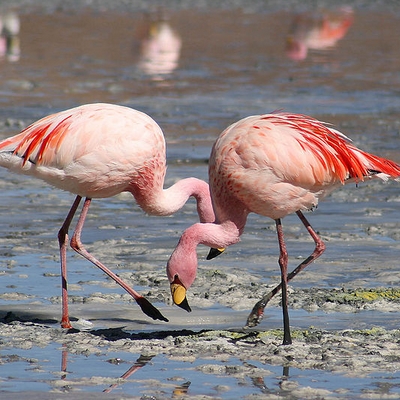
Crazy Facts About Flamingos
- There are 19 bones in a flamingo’s neck.
- That trademark bend halfway down a flamingo’s leg is not actually a knee but is instead an ankle.
- Flamingos don’t just stand on one leg in the water because it looks cool or because they heard it strengthens their core muscles (which is totally does, by the way). Flamingos actually stand on one leg because it reduces the amount of body heat the flamingo loses in cold water.
- Flamingos generally only lay one egg at a time which is probably pretty lucky for the flamingo as that single egg weighs between 115 and 140 grams. The unlucky few that do manage to lay two often only see one of them hatch.
- The Philadelphia zoo was home to the oldest flamingo in known history that lived to age 44.
- In what has to be an evolutionary oversight, flamingos can only eat when their heads are upside down. I’m sure this has something to do with procuring food under water but it still seems like poor design.
- Flamingos get their pink color via their diet, which consists mainly of shrimp and algae. Flamingos may not prove you are what you eat but they do prove you’re the color of whatever you eat. Well, maybe not.
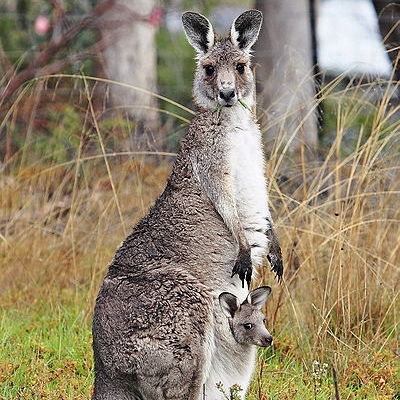
Crazy Facts About Kangaroos
- Kangaroos are the only large animals that move by hopping.
- A group of kangaroos is called a mob – one of those weird animal facts that makes me laugh every single time.
- Kangaroos are not able to hop backwards.
- Kangaroos can swim.
- Kangaroos don’t waste their methane on silly things like farting. No, kangaroos reuse that methane thanks to their body’s ability to convert that methane into energy.
- While today there are only eight known species of tree kangaroos, it is believe the ancestors of modern kangaroos were all tree living animals.
- When a baby kangaroo is born, it is no bigger than the average queen bee.
- Because kangaroos use their tails for balance, if you lift a kangaroo’s tail off the ground it will no longer be able to hop.

Crazy Facts About Koala Bears
- Male koalas have scent glands in their bellies which they use to mark their territory. This basically means that male koalas mark their territory by rubbing their bellies on trees; much, much cuter than lifting a leg and peeing on something.
- A baby koala will stay inside its mother’s pouch until it is roughly six months old. This gives me the greatest idea for a cartoon ever. Ready? Okay – the story focuses on a mother koala and her baby that just won’t grow up and get out of her pouch. Hilarity ensues. Watch for it – coming soon on Fox.
- The word ‘koala’ means, “animal which does not drink” which is a reference to the fact that koalas drink very little water. Their main diet consists of eucalyptus.
- It is believed that the extra fur on a koala’s butt is there to make sitting on branches for long periods of time more comfortable.
- Despite being referred to as koala bears, koalas are actually not a member of the bear family.
- Koalas are solitary animals, preferring to stay alone much of the time. They also sleep up to 20 hours a day. These two facts have led me to believe I may actually be a koala.
- Koalas communicate by snoring and belching. Yes. I am most definitely a koala.

Crazy Facts About Lions
- Much like other big cats, the life expectancy for the lion is much longer in captivity than it is in the wild. In captivity, lions can live up to 20 years while in the wild, the expected lifespan of a healthy lion is only 14 years.
- Lions lead a pretty laid back life, walking for roughly 2 hours each day, eating for about 50 minutes and spending the rest of the day relaxing.
- The heaviest lion in known history resided at the Colchester Zoo in India. His name was Simba and he tipped the scales at 862 lbs. The longest lion in known history was 12 feet long from nose to tail.
- Out of all the big cats, lions are generally the tallest. At their shoulders, male lions can stand up to 4 feet tall while the average female is a bit shorter, reaching only 3 feet tall.
- When male lions reach maturity, they are often excluded from the pride.
- The smaller, faster, more agile female lions are the hunters of the pride.
- Despite their sharp teeth and claws, lions do not kill their prey with them. Instead, the lion’s prey is often strangled.
- If there isn’t enough food to go around, lions will take food from cheetahs, leopards, hyenas and other large predators.
- Lions do not exclusively breed with other lions. They have also been known to breed with tigers. The resulting offspring is named depending on which species played which role. Ligers are the offspring of a male lion and a female tiger while tigons are the offspring of a male tiger and a female lion.
- Lions carry their deaf and blind newborn cubs from den to den so the scent of the cubs will not attract predators.
- The average lion in the wild makes less than 20 kills per year.
- The roar of a lion can be heard from 8 km away, making it the loudest roar produced by any big cat.
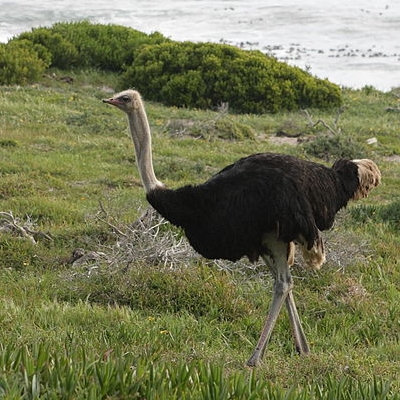
Crazy Facts About Ostriches
- In terms of running speed, ostriches are faster than horses. This one amazes me and really makes me feel like an ostrich vs. horse race needs to take place ASAP and I need to see it. Badly.
- Not content to just be faster than horses, male ostriches can also roar like lions. I can’t fathom how discerning that would be, say, at a zoo. “Oh honey – look at the ostriches! Did it just … roar? Yup. Time to lay off the pot.”
- Ostriches are built for speed with two toes on each foot. I’m not sure how that makes them faster, now that I think about it but I guess it’s working out alright for them.
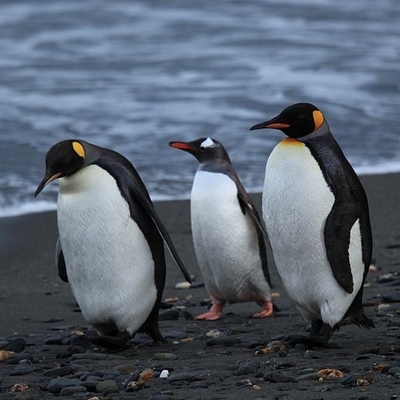
Crazy Facts About Penguins
- There isn’t a lot of fresh water where penguins reside so they actually eat snow to get the fresh water they require. It is not known whether or not anyone has ever warned them about yellow snow though.
- Despite the fact that their bellies are white and their heads and backs are black, the name “penguin” comes from the Dutch words “pen” meaning head and “gwyn” meaning white.
- Baby penguins begin calling out the moment they hatch from their egg. They do this to make sure their parents are able to recognize their voice.
- Penguin wings aren’t as useless as they may seem. While they don’t use their wings for flying, they are quite useful for swimming, acting as really adorable paddles and helping penguins reach swimming speeds up to 15 mph.
- Penguins are capable of jumping up to 6 feet out of the water which is absolutely adorable if you’ve ever seen it. They just shoot out of the water like the cutest bullets ever.
- The first known penguin can be traced back at least 40 million years.
- Although the Emperor penguin is probably the most recognized species of penguin, there are actually 17 distinct breeds of penguin out there.
- A prehistoric penguin skeleton discovered proves ancient penguins were significantly larger than the ones we’re familiar with today. Based on the skeletal evidence, it is believed the ancient penguin may have stood as tall as 5 feet.
- The very first penguin fossil uncovered was discovered among rocks that were roughly 25 million years old.
- Because penguins do their hunting in the water, the majority of a penguins life, roughly 75% of it, is spent in the water.
- The average lifespan of a healthy penguin ranges from 15-20 years.

Crazy Facts About Polar Bears
- Polar bears are the largest predator that lives its life on land but they don’t start out that way. Baby polar bears are no larger than the average rat and they weigh less than 1/2 kg.
- 60% of the world’s polar bears live in Canada although they can also be found in Russia, Alaska, Greenland, Norway and the island from Lost.
- It is illegal to hunt polar bears in Canada, Russia, Alaska, Greenland and Norway. Although they are generally safe from hunters where their numbers are strongest, climate change is still a threat to them.
- The average life span of a healthy polar bear is 25 years.
- Polar bears do not give off any detectable heat so they are not able to be photographed with infrared cameras.

Crazy Facts About Rabbits
- Despite what many believe, rabbits do not actually belong to the rodent family. They’re actually members of the lagomorph family.
- If properly cared for, a rabbit can live up to 10 years and sometimes even longer. My beloved Commander Bun Bun made it to just shy of 10.
- Rabbits are capable of making sounds that closely resemble sounds you would expect to hear from a cat.
- Rabbits are unable to vomit.
- Rabbits do in fact sweat but they are only able to sweat through the pads on the bottoms of their feet.
- A rabbit only has 28 teeth but those teeth are extremely strong and never stop growing.
- Rabbits are able to begin reproducing at only 3-4 months old.

Crazy Facts About Sheep
- A castrated ram is called a wether.
- The placement of a sheep’s eyes offers it a 300 degree field of vision which means it can see behind itself without having to turn its head.
- A sheep on its back is unable to get back to its feet.
- According to research, roughly 8% of rams are attracted to other rams. I’m not sure how or why this was researched but there that is.
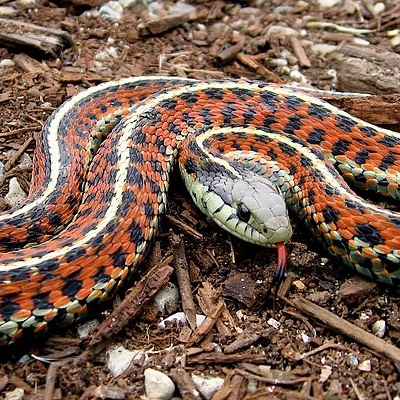
Crazy Facts About Snakes
- There are more than 2,700 different kinds of snakes in the world but none of those kinds of snakes can survive in an environment where the ground is frozen all year round.
- The scales on a snake do the reptiles a valuable service; allowing them to move through hot, rough or wet surfaces without being harmed in any way. These scales are a sort of armor for the snake while remaining waterproof.
- Although all snakes smell using their tongues, some snakes are actually able to smell using their noses.
- Snakes determine the size of their prey using vibrations in the ground.
- A snake’s teeth are not used for chewing. Instead, snakes use their teeth to grip their prey before swallowing it whole.
- Some snakes are capable of eating prey as large as a hippo thanks to the fact that their jaws are not attached at the back of their mouths.
- Snakes that live in colder climates hibernate in the winter while snakes that live in warmer climates do not hibernate at all.
- Snakes are adaptable to many different climates because they can use the sun to change their body temperature; staying out of the sun to cool their body temperature and lying in the sun to make their body temperature rise.

Crazy Facts About Swans
- Swans are monogamous animals – choosing one mate and sticking with them for life.
- Black swans are native to Australia.
- The male swan is called a cob while the female swan is called a pen. The baby swan is called a cygnet. I don’t know why I find that as interesting as I do but there it is.
- Swans can fly up to 60 mph.
- Not only are swans highly intelligent, they have the ability to remember and recognize who has been kind to them and who has not been kind to them.
- A group of swans in captivity is called a fleet while a group of swans in the wild is called a herd.
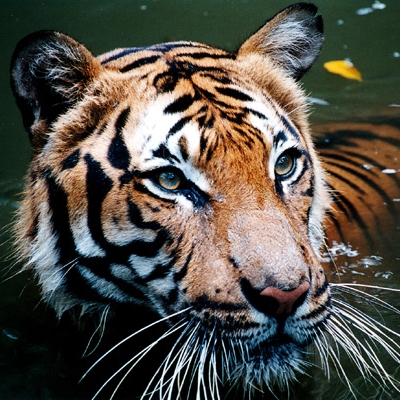
Crazy Facts About Tigers
- A tiger’s stripes are as unique as a human being’s finger prints. I’m not sure why, but I found that one absolutely fascinating.
- Tigers are able to eat 75 lbs of flesh in one meal but despite, or perhaps because of, their rather large meal sizes tigers can survive two weeks without eating.
- While perhaps not as impressive as some of the animals we’ve talked about, a tiger can leap approximately 33 feet horizontally.
- The stripes of a tiger are more than just markings on their fur. The tiger’s skin is stripped as well.
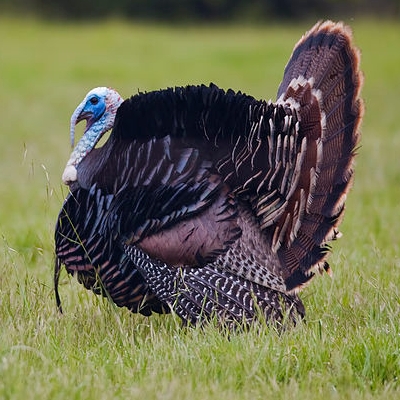
Crazy Facts About Turkeys
- I tried to leave “males are called …” “females are called …” and “babies are called …” facts off this list because by now, most of them are common knowledge but this one was totally new information to me so I had to share. While I knew female turkeys are called hens, I was surprised to learn male turkeys are called stags and their babies? Possibly the cutest baby name I’ve ever heard. Yes, baby turkeys are called “poult”.
- You know that dangly piece of skin that hangs down on top of a turkey’s beak? That is called the “snood” – a word which has now become my personal favorite insult. “You worthless snood!” See? It works. The flesh that hangs under the turkey’s beak is called the “wattle” which I had heard but was quite convinced couldn’t possibly be true.
- A group of turkeys is called a rafter.
- Turkey poop is an effective fuel and has been used in power plants since 2007. You can get roughly 55 megawatts of power from 500,000 tons of turkey pooh.
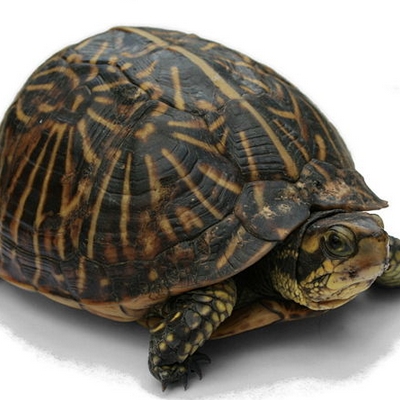
Crazy Facts About Turtles
- Turtles can be found on every continent in the world … every continent except Antarctica.
- The gender of a turtle can be determined by the sounds it makes. Male turtles made make grunting sounds while female turtles make hissing sounds.
- Not all turtles and tortoises hibernate. The ones that do hibernate, however, have blood that works much the same way as antifreeze. This allows them to go into their hibernation state in cold temperatures.
- Although there are roughly 300 distinct species of turtle, none of those species come from underwater eggs. All female turtles, regardless of species, lay their eggs on land.
- Turtles are often thought of as the slowpokes of the animal kingdom but that is actually a misconception. While there are certainly slow turtles out there, there are also turtles out there capable of outrunning human beings.
- It is believed that turtles can be traced back 200 million years.

Crazy Facts About Whales
- Orcas, beluga whales and sperm whales have small teeth they use for hunting.
- The smallest whale in known history was a pygmy sperm whale that measured only 3.5 meters. The largest whale, on the other hand, was a blue whale that measured in at 30 meters and weighed 180 tons.
- The closest living relative of the whale is the hippopotamus.
- Whales are warm blooded mammals.
- Toothed whales have only one blowhole while baleen whales have two.
- This one is pretty well known but I felt the need to share it anyway. Killer whales (Orcas) actually belong to the dolphin family, not the whale family. I can see why they’re called ‘killer whales’ though. ‘Killer dolphins’ just doesn’t have the same ring to it.
- The weight of the average blue whale is roughly equal to the weight of thirty average elephants. The average blue whale is also as long as three Greyhound buses parked end to end.

Crazy Facts About Wolves
- Wolves are the largest member of the canine family. A full grown wolf may measure up to 5 feet in length and stand 3 feet tall. The heaviest wolf in known history weighed a shocking 130 lbs.
- Domestic dogs and wolves share many common traits and are closely related in terms of their genetic makeup.
- There isn’t just an alpha male in a pack of wolves. There is also an alpha female. The alphas are determined by strength, with the strongest male and female taking the positions and leading the pack.
- Becoming the alpha wolves has its benefits outside of being in charge. The alpha pair is the only pair in the pack that will mate. It makes sense in an evolutionary way but boy that has to suck for the betas.
- Wolf pups are born deaf and blind so the mother will live in underground dens throughout the spring to care for her pups in the safest possible conditions.
- Caring for the pups once they are able to see and hear isn’t just the responsibility of the alphas. Instead, caring for the pups is the responsibility of the entire pack.
- The howl of a single wolf can be heard up to 10km away.
- No part of a wolf’s meal is wasted. They eat up to 9kg at a time and that includes the meat, bones, and fur of their prey.
- In just one day, the average wolf is capable of traveling up to 200km.

Crazy Facts About Random Animals
- Gorillas are able to catch colds and not just any colds, human colds. They can also catch other human illnesses, something many animals cannot do. This brings to mind images of a gorilla with the sniffles and that both amuses me and makes me feel sad.
- Nearly half of the world’s total pig population can be found in China. This one makes sense when you really think about it but I was still surprised. Perhaps I haven’t given the planet’s total pig population enough thought … or perhaps I’ve given it too much.
- The only animals that go through menopause are human beings, elephants and humpback whales.
- In terrifying news, a tarantula can survive more than two years without food. Good news for the tarantula. Bad news for anyone deathly afraid of all things with eight legs.
- Goldfish get their pigment from light so if you place a goldfish in a dark room, it will not remain yellowy/orange but will instead become pale.
- I sometimes wonder how (and why) these theories are tested. This is one of those times. According to researches with too much time on their hands, cows only dream while they’re lying down although they can sleep while standing up. Now we know and somehow our lives are better for it, I’m sure.
- While hard to say exactly, it is believed the average cow poops up to 16 times each day.
- I was a big baby. I came into this world weighing 9 pounds and five ounces. This means, at birth, I weighed only 5 ounces more than what researchers believe is the maximum weight of the average elephant tooth. In other words, it is believed that a single elephant tooth can weigh as much as 9 pounds. Chew on that with your puny people teeth.
- When I hear a housefly buzzing around, music isn’t exactly the first thing that comes to mind but somewhere, someone felt differently and realized houseflies hum in the key of ‘f’ – which is awesome to know for some reason.
- Scorpions cannot handle their alcohol. Place even a small amount of alcohol onto a scorpion and it will immediately lose its marbles, stinging itself to death in what I have to assume is a drunken rage. I can only imagine how this one came to be a theory to be tested in the first place. I’m guessing some drunk college kid decided to try to get his pet scorpion drug with tragic results.
- Ants don’t sleep. Now, I’m a big fan of sleep. I like it a lot – do it as often as possible. Naps mid-afternoon? One of the great pleasures in life and is a big part of the reason I would not like to be an ant. Well, that and the crawling through dirt thing. That doesn’t sound like much fun either, especially if I can’t have a nap afterwards.
- Still on the subject of ants, ants don’t have lungs. So ants don’t sleep and they don’t have lungs. Are we certain they’re actually real living creatures and not just tiny little robots? I think I’d like to see a scientific study on that.
- This one is a two for one crazy animal fact. As most people know, a group of crows is called a murder. What you may or may not know is that a group of owls in called a parliament. The question I need answered: if a group of crows flies into a group of owls, would one then say there was a murder in the parliament?
- If you’ve ever observed a grasshopper for any length of time, you know those little suckers can jump. What you may not know, however, is that the average grasshopper can jump as high as twenty times the length of its body. Let’s put that in perspective. Imagine yourself standing up. Now imagine another one of you standing on your shoulders. Now imagine eighteen more of you stacked on your shoulders in a similar way, going straight up. That is how tall you could leap if you were a grasshopper.
- Grasshoppers seem pretty dang impressive … until you consider the average flea can leap up to 200 times the length of its body. Now that is impressive.
- In terms of running speed, hippopotami are faster than human beings. This was a fun one because it allowed me to use the plural of hippopotamus, which is always a great time.
- Here’s a weird one. Male iguanas, koalas and komodo dragons have two penises. An interesting related fact? Female koalas have two vaginas.
- The woodpecker is capable of pecking up to twenty times per second. It sounds like far more when there’s a woodpecker on a tree outside your bedroom window in the morning who decides to wake you up looking for his breakfast.
- For reasons I will never be able to comprehend or understand, scientists have performed brain surgery on cockroaches.
- Here’s something you’ve probably never considered when looking over your garden. The garden caterpillar has an astounding 248 muscles in its head.
- Remember the old wives’ tale about moths eating clothes and blankets? The culprit was certainly not the adult moth as adult moths do not have stomachs or even mouths. This means they’re also not able to bite so they’re pretty much completely harmless.
- Want to go on a trip to the desert but scared of dying of thirst? Consider taking an elephant. Elephants can smell water that is up to three miles away. The logistics of traveling with an elephant might become problematic though so maybe just stock up on the wet stuff or, perhaps, don’t go.
- Elephants have prehensile penises. What does that mean? Ya know what? I’m going to let you look that one up. It’s so disturbing in the most hilarious way.
- Spot a skunk while out on a hike? No big deal. A skunk will not throw its scent and bite at the same time. Okay, so kind of a big deal but hey, at least you’ll get bitten or get smelly – not both.
- If a snail’s eye is severed, it will grow a new eye. That just creeps me out. I can’t determine why it creeps me out but it does all the same. But hey, I guess that’s good news for the snail, especially if its eye was recently severed. Don’t worry, little dude. It’ll grow back like a bad haircut.
- The first animal domesticated by man was not the cat, the dog or even the horse. No, the first animal domesticated by man was the goat and it is believed the goat was first domesticated in 10, 000 BC.
- Pygmy seahorses are less than 1 inch long and are nearly invisible to the naked eye.
- The coloration of pygmy seahorses depends on the coral they anchor themselves to. They can be either dull grey or bright red for that reason.






